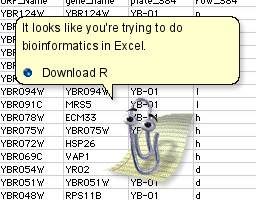Using spreadsheet programs for scientific data
Authors:Christie Bahlai, Aleksandra Pawlik
Contributors: Jennifer Bryan, Alexander Duryee, Jeffrey Hollister, Daisie Huang, Owen Jones, and
Ben Marwick
Spreadsheet programs are very useful graphical interfaces for designing data tables and handling very basic data quality control functions.
The cardinal rules of using spreadsheet programs for data:
1. Put all your variables in columns
2. Put each observation in its own row
3. Don’t @#$%! with it
4. Export to a text based format like CSV.
In reality, though, many scientists use spreadsheet programs for much more than this. We use them to create data tables for publications, to generate summary statistics, and make figures. Generating tables for publications in a spreadsheet is not optimal- often, when formatting a data table for publication, we’re reporting key summary statistics in a way that is not really meant to be read as data, and often involves special formatting (merging cells, creating borders, making it pretty). We advise you to do this sort of operation within your document editing software.
The latter two applications, generating statistics and figures, should be used with caution: because of the graphical, drag and drop nature of spreadsheet programs, it can be very difficult, if not impossible, to replicate your steps (much less retrace anyone else’s), particularly if your stats or figures require you to do more complex calculations. Furthermore, in doing calculations in a spreadsheet, it’s easy to accidentally apply a slightly different formula to multiple adjacent cells. When using a command-line based statistics program like R or SAS, it’s practically impossible to accidentally apply a calculation to one observation in your dataset but not another unless you’re doing it on purpose.
HOWEVER, there are circumstances where you might want to use a spreadsheet program to produce “quick and dirty” calculations or figures, and some of these features can be used in data cleaning, prior to importation into a statistical analysis program. We will show you how to use some features of spreadsheet programs to check your data quality along the way and produce preliminary summary statistics.
In this lesson, we will assume that you are most likely using Excel as your primary spreadsheet program- there are others (gnumeric, Calc from OpenOffice), and their functionality is similar, but Excel seems to be the program most used by biologists and ecologists.

In this lesson, we’re going to talk about:
